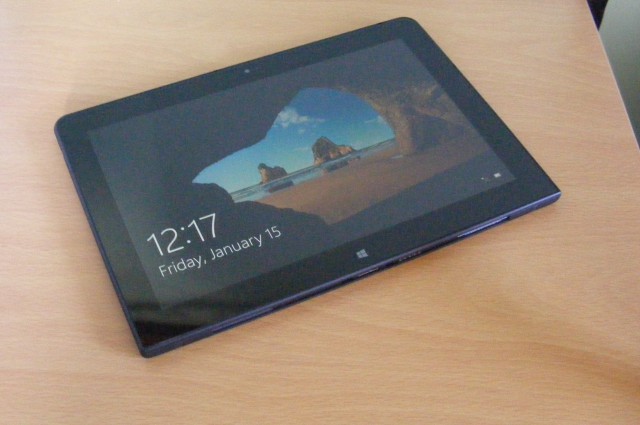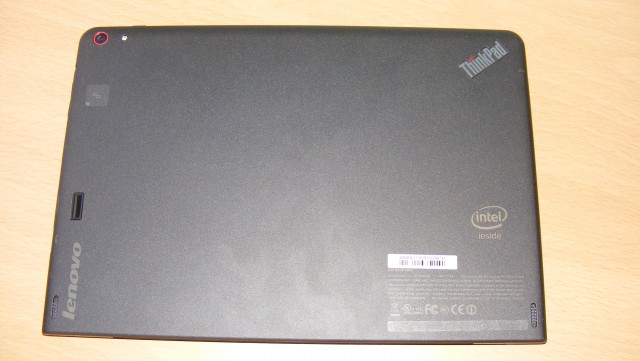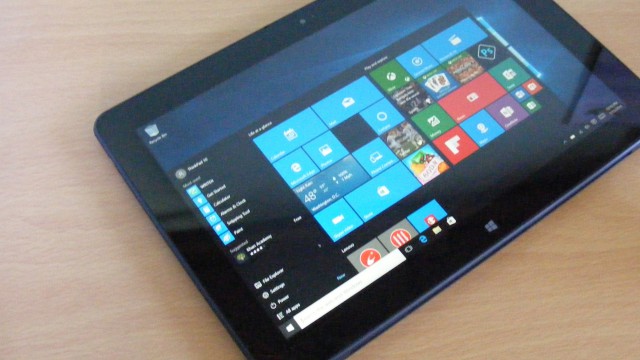Lenovo ThinkPad 10: A viable laptop substitute [Review]

The majority of tablets are aimed at consumers and, therefore, business features can sometimes feel a little tacked on. Some manufacturers take a different approach, however, and there is little doubt that latest second generation of ThinkPad 10 from Lenovo is not aimed squarely at business users.
It runs 64-bit Windows 10, has Trusted Platform Module encryption and other features and options that will make it an attractive corporate choice. Add in the fact that it is solidly built and has lots of accessories available to improve its usefulness as a business tool and it looks even more impressive, and even more similar to the Microsoft Surface. So, is this a better option for serious tablet users than a device based around a mobile OS, like Android?
In the Box
The ThinkPad 10 comes in both 2GB and 4GB memory versions, and both are powered by the quad-core Intel Atom x7-Z8700 Processor with 2MB of cache and integrated HD graphics.
The 2GB versions come with 64GB of on-board storage while 4GB models have 128GB; in either case you can extend this by adding a microSD card. The 4GB versions are available with or without mobile web access, although it is only 3G; if you do opt for the mobile version you also get Windows 10 Pro installed as opposed to the Windows 10 Home version on the other models.
The front camera is 1.5MP and the rear is 5MP and it comes with auto-focus and flash; it is capable of recording 1080p video too. The tablet has a 10.1 inch multi-touch Gorilla Glass screen with 1920 x 1200 resolution. Connectivity is via 802.11 a/c Wi-Fi, Bluetooth 4.0, and, in the top versions, 3G mobile.
There is a built in Swipe fingerprint reader on all versions. Optional extras on offer include a built-in SmartCard reader, NFC, and the ThinkPad Pen Pro with WRITEit allowing you to use stylus input.
As standard you do not get a lot in the box other than the tablet itself and a mains charger. This does not have a standard USB connection but uses a proprietary plug so you will need to make sure you have the charger with you if you are out and about and likely to run short of juice. Talking of which the battery should be able to deliver up to 10 hours of life on a full charge.

As to the design of the tablet itself, there is a power switch on the top edge, on the right are volume controls, microSD and SIM card slots plus ports for HDMI, USB 3.0, headphones and power. On the left-hand side is a Kensington lock slot, and on the bottom edge are the connectors for a case/keyboard or docking station. The fingerprint sensor is on the back and is positioned so that it falls neatly under your right forefinger when you are holding the device in landscape format.
Business Features
The ThinkPad will attract business users for a number of reasons. Most obviously because it runs the familiar Windows platform, so compatibility with MS Office documents is assured and users can easily sync system settings via their Windows ID.
Trusted Platform Module encryption ensures that your data stays secure and for those wanting even more protection there is the option of a smart card reader to augment the standard fingerprint scanner. Other attractive add-ons for business users include the Folio Keyboard, which is a keyboard, touchpad and case combined, allowing you to use the device like a conventional laptop.
There is also the option of the Pen Pro stylus, plus a desktop dock that offers keyboard, mouse, USB, HDMI and audio ports as well as an Ethernet connector so you can use the machine in the office. The Pen Pro comes with a holder to keep it safe but this attaches to the USB port thus denying you access to it for other purposes. You can see from this collection that Lenovo is serious about cracking the business market -- though of course all of these things ramp up the cost of the device.

There are a couple of useful pre-installed apps too. REACHit allows you to search for files across all of your devices and cloud storage from a single screen, and SHAREit which is a cross-platform file transfer tool.
Order direct from the Lenovo website and you can mix and match the options you want, and add software, upgrading from Windows 10 Home to Windows 10 Pro, for example, or adding Office. The problem is that once you have built it up you could have bought a decent laptop for the same money.
In Use
The back of the ThinkPad has a smooth matt finish which feels nice to the touch, though it does tend to show marks and fingerprints. It has a red power LED that forms the dot over the "i" in the ThinkPad logo, which is a pleasing design feature. There is also a subtle red highlight around the rear camera lens.
The back does look a bit busy though, with copyright information and an Intel Inside and Lenovo logos printed on it, plus the fingerprint scanner, NFC touchpoint and speaker recesses. There is a slight design quirk in that the top corners are rounded, while the bottom ones are square; this, presumably, is to aid docking, attaching keyboards, etc, but it does make the tablet look a little odd, as though it is part of something else.
It may not be the best looking tablet in the world then, but there is no doubt that it feels rugged and is likely to survive the day-to-day rigors of corporate life. Lenovo’s website makes much of its premium construction, stress testing and reliability. The buttons for power and volume are plastic, but they do not feel cheap.
The ThinkPad is a relatively heavy beast compared to, say, a Galaxy Tab. It weighs almost 600 grammes (1 pound 5 ounces in old money) and you would not want to hold it one-handed for long. It also gets quite warm in operation at around the bottom right corner, particularly when it is charging, and this is just the spot at which you hold it.

The tablet boots up and shuts down very quickly and it copes well with most everyday tasks, including music and video streaming, without breaking a sweat. It also switches between open apps with minimal lag. The ThinkPad 10 copes well with legacy Windows programs too, which can sometimes be rendered uncomfortably small on tablet screens. When you turn it from landscape to portrait, however, there is always a slight delay before the screen decides to reorient itself.
It has a wide black bezel around the screen, which makes the tablet feel rather larger than it needs to be, but you quickly get used to this and, on the flip side, it does make it easy to hold without accidentally triggering functions. The Windows logo below the screen is not there just for show; it also acts as a Windows Start button, which is a neat touch.
You get the advantage of a full-sized USB 3.0 connector; however, it is hidden under a little rubber cover which is quite fiddly to open and is not tethered to the chassis, so you will no doubt end up losing it. If you have an NFC enabled version, the touch point is just below the camera and is marked with a small label for ease of location.
The screen itself is one of the ThinkPad’s most impressive features; it is bright and responds well and accurately to touch inputs. It delivers smooth video playback too and if you are apt to play Candy Crush under the table during boring meetings it will not disappoint there either. The resolution is good and the size feels just about right, making use of the on-screen keyboard comfortable with minimal risk of mistyping.
The speakers are on the back, down towards the bottom edge, which makes them easy to cover with your hand when you are holding the device. Sound quality is okay, though it is not room-filling, but it has enough bass response to allow you to feel a slight vibration through your fingers.

Although it is only 5 megapixel, the ThinkPad’s rear camera captures pictures that are sharp and bright with good levels of detail and accurate colors. It is at least as good as most tablet cameras, though it does not compare to those found on the latest smartphones. Things can be a bit grainy in low light if you opt not to use use the flash, and this is even more pronounced on the rear camera, but it is good enough for video calling.
It comes with some Lenovo programs pre-installed, including Companion, Lenovo ID, and the REACHit and SHAREit apps mentioned above. There is also a trial of McAfee LiveSafe installed, but otherwise the ThinkPad is commendably free of bloatware. You can opt for various software packages when ordering, including Office -- or an Office 365 subscription -- Photoshop Elements and various security options.
One of the attractions of the ThinkPad is that it allows you to operate in the familiar home comfort of Windows, but that is also a source of some of its frustrations. The on-screen keyboard, for example, has big buttons, but to access numbers you either need to switch to numeric mode or use a less than intuitive press and hold technique.
Also, when you press on an input field the keyboard does not automatically appear as it does on Android, you have to start it manually. The Camera app too feels rather underdeveloped compared to those on other platforms. You can address some of these issues with a visit to the Windows Store, but even so there is not the choice of alternatives that you get on iOS or Android.

There is a wide selection of accessories available for the ThinkPad, mostly aimed at business use as we noted above. For more general users -- particularly those who use the camera a lot -- there is a Quickshot cover that has a neat fold-down corner, which exposes the camera lens and launches the camera app. It also has a magnetic closure that automatically puts the tablet into sleep mode when closed and wakes it again when opened.
Conclusion
As a tablet in its own right the ThinkPad 10 has a lot to like, but is let down by one or two minor niggles; but, to be fair, some of those are down to Windows rather than the device itself. It is an attractive business proposition though, thanks to the compatibility of its Windows OS, its security features and the availability of accessories that allow you to effectively bridge the laptop/tablet gap.
The 2GB version costs £459.99, while the top of the range 4GB smart card version is £709.99. This makes the Lenovo look a bit pricey against Android tablets, especially of you start adding keyboards and styluses, but then it is not really a direct competitor. It is a machine that is more likely to be bought by companies to equip their employees, rather than by BYOD or personal users.
Looked at in that light, the ThinkPad 10 is a robust device that offers an alternative to the Microsoft Surface. It lacks the Surface Pro 4’s faster Core CPU, but otherwise offers a similar spec at a slightly lower price point, though with either machine you will pay extra if you want to add a keyboard. Even so, if you are looking for a tablet that can serve as a viable laptop substitute, the ThinkPad 10 is worth adding to your shortlist.
That said, there are plenty of alternatives in the form of laptops that use 360 degree hinges or detachable screens to give similar functionality, plus, up at the top of the ThinkPad’s price range, you are getting close to the Surface Pro 4 with its larger screen and faster Core CPU.
Pros
- Security features
- Build quality
- Impressive screen
Cons
- Heavy
- Pricey
- Limited app choice
8/10
Published under license from ITProPortal.com, a Net Communities Ltd Publication. All rights reserved.